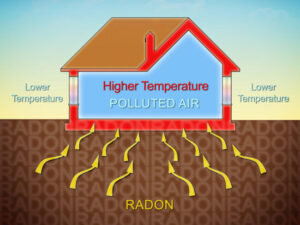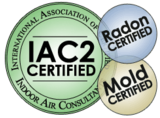
Many home owners or home buyers use radon testing as part of the real estate transaction process. The EPA recommends that if you are buying a home or selling your home, have it tested for radon. Testing is the only way to find out your home’s radon levels. The EPA and the Surgeon General recommend testing all homes below the third floor for radon.
The good news is that if you find that you have high radon levels, there are ways to fix a radon problem. Even very high levels can be reduced to acceptable levels.
What is radon?
Radon is a radioactive gas that has been found in homes all over the United States. It comes from the natural breakdown of uranium in soil, rock and water, and gets into the air you breathe. Radon typically moves up through the ground to the air above, and into your home through cracks and other holes in the foundation. Radon can also enter your home through well water. Your home can trap radon inside.
Any home can have a radon problem, including new and old homes, well-sealed and drafty homes, and homes with or without basements. In fact, you and your family are most likely to get your greatest radiation exposure at home. That is where you spend most of your time.
Nearly one out of every 15 homes in the United States is estimated to have an elevated radon level (4 pCi/L or more). Elevated levels of radon gas have been found in homes in your state.
How do I understand a Radon Report from HomeTech?
Radon testing is an average of levels measured during a 48 hour test period. During this period, 48 separate readings via motion sensor machines are recorded. These are measured in a graph format. Usually all levels are similar, if we see a few unusual spikes, this could be a reason for a retest.
Radon is measured by pCi. A pCi is a measure of the rate of radioactive decay of radon. One pCi is one trillionth of a Curie, 0.037 disintegrations per second, or 2.22 disintegrations per minute. Therefore, at 4 pCi/L (picocuries per liter, the EPA’s recommended action level), there will be approximately 12,672 radioactive disintegrations in one liter of air during a 24-hour period.
The average tolerance per the EPA is 4.0 pCi/L – if we test a house and results are 4.0 or above, it’s strongly recommended that remediation steps are taken. If results come in at 3.9 pCi/L or lower no immediate action is required.
Don’t worry if you’re getting confused by all this science, most radon reports are easy to understand – before we send it out any report, we’ll look for problems and give homeowners or buyers a heads up on what to expect.

